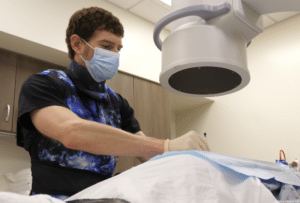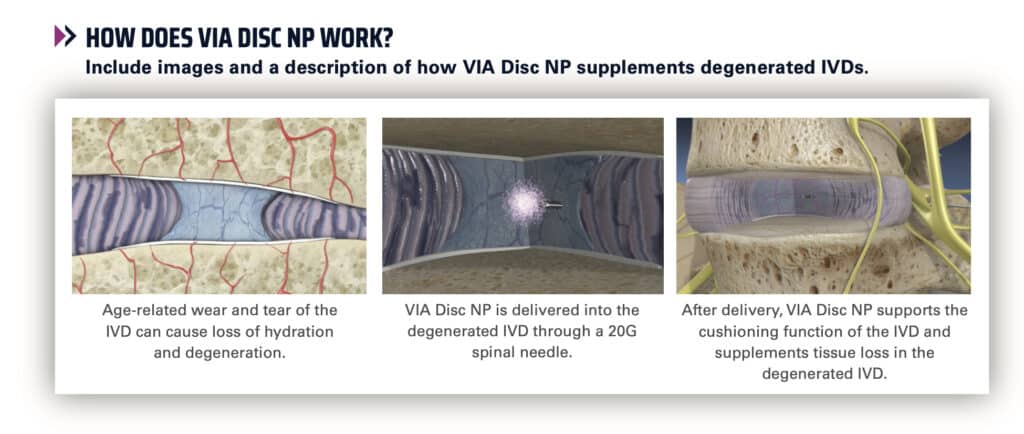 An epidural steroid injection is one non-surgical approach to relieving your back and neck pain. In the past, your back doctor had to perform this injection in a hospital or outpatient hospital suite. The Southeastern Spine Institute (SSI) has its own complete in-house block suite, which means we can help you right in our own office here in Mt. Pleasant.
An epidural steroid injection is one non-surgical approach to relieving your back and neck pain. In the past, your back doctor had to perform this injection in a hospital or outpatient hospital suite. The Southeastern Spine Institute (SSI) has its own complete in-house block suite, which means we can help you right in our own office here in Mt. Pleasant.
Our block suite is equipped with a state-of-the-art fluoroscope that enables our board-certified doctors to deliver pain medicine directly where it’s most needed. These treatments include the celiac plexus block and the stellate ganglion block. You can find the complete list of pain block injections at the bottom of this page.
WHAT IS AN EPIDURAL?
Most commonly associated as a pain treatment for mothers giving birth, an epidural is an injection of steroidal medication directly into the epidural space of the spine. The epidural space is between the outer dura mater membrane and the bony vertebral wall, located just outside the dural sac. The dural sac surrounds the nerve roots and cerebrospinal fluid.
An epidural is a safe, effective, non-surgical pain relief treatment. But there are other reasons our back doctors may recommend an epidural injection for you, such as for inflammation and rehabilitation. The different types of epidural steroids injection are described next.
EPIDURAL STEROID INJECTIONS FOR INFLAMMATION
When you’ve suffered a herniated disc in your lumbar or lower spine, the inflammation can cause significant nerve root irritation and swelling. It’s the inflammation that actually causes the pain you feel.
Steroid-based medications (corticosteroids) have been shown to reduce inflammation by inhibiting the production of substances that cause the inflammation. An epidural steroid injection is very effective because it delivers the medication directly to the site of inflammation.
EPIDURAL STEROID INJECTIONS FOR REHABILITATION
In general, your back doctor gives you an epidural steroid injection to provide pain relief so you can make progress with your rehabilitation. With less back pain, you feel more comfortable and are better able to perform physical therapy (PT).
Active therapies such as stretching, strengthening, pain relief exercises and low-impact aerobic conditioning help you rehabilitate your lower back. PT also helps prevent or reduce the risk of low back pain in the future. Being able to do your rehabilitation pain-free encourages you to do the exercises.
EPIDURAL STEROID INJECTIONS FOR PAIN
There are many reasons and diagnoses for which your back doctor will give you an epidural steroid injection. It’s a safe and effective non-surgical treatment option for pain relief, and our doctors always follow a conservative approach first.
A lumbar herniated disc, degenerative disc disease and lumbar spinal stenosis are common causes of acute or chronic low back pain and/or leg pain. For these and other conditions that cause chronic pain, your SSI physician may recommend an epidural steroid injection instead of surgery.
THE EPIDURAL STEROID INJECTION PROCEDURE
An epidural steroid injection usually takes between 15 and 30 minutes. You lie flat on your stomach on an X-ray table. Before the procedure, your doctor numbs your skin where he or she will make the injection. Your doctor uses lidocaine, which is similar to the novocaine that dentists use. Lidocaine, like novocaine, is a local anesthetic, numbing only the area where it’s applied.
Your SSI doctor uses a fluoroscope during the procedure. By providing live X-ray images, fluoroscopy helps your doctor guide the needle accurately into the epidural space. Controlled studies found that steroid medication was injected incorrectly up to 34 percent of the time without fluoroscopy.
Once your doctor has placed the needle in the exact position it needs to be, he or she injects the epidural steroid solution. Following the injection, you will usually be monitored for 15 to 20 minutes before being discharged to go home.
Sedatives are rarely necessary because the injection procedure isn’t usually uncomfortable. If you experience any anxiety or discomfort, your doctor can give you a sedative, but then you will have to be monitored for a longer period after the injection, and you may have to arrange for a ride home.
On the day of your epidural steroid injection, you must rest. You can typically resume your normal activities — those that you’ve done the week prior to the epidural injection — the day following your injection.
TYPES OF INJECTIONS
Listed below are the types of pain block and steroid epidural injections offered by the doctors at SSI. If you have specific questions, please contact us.
- Caudal Steroid Injection
- Celiac Plexus Block
- Cervical Epidural Steroid Injection
- Epidural Steroid Injections
- Facet Joint Injections
- Fascia Iliaca Block
- Lumbar Epidural Steroid Injection
- Lumbar Sympathetic Block
- Lumbar Transforaminal Epidural Steroid Injection
- Medial Branch Block
- Occipital Nerve Injections
- Sacroiliac Joint Steroid Injection
- Selective Nerve Root Blocks
- Stellate Ganglion Block
- Trigeminal Nerve Block
- Trigger Point Injection
Conservative care & rehabilitation (non-surgical procedures)

